|
Hi everybody, I'm StarkingBarfish and I am working on one of the experiments of the Large Hadron Collider. 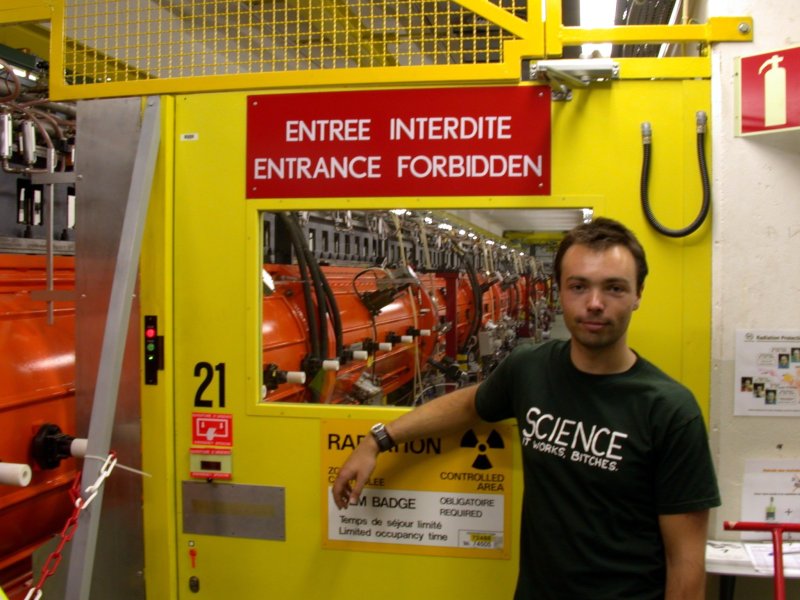 There have been a whole heap of threads here recently about the LHC mostly containing the same questions, jokes and misconceptions. At this stage I reckon it is a good idea to make a megathread to keep it all in one place. I'll update this thread with information as I get it, and will answer any questions people have if I can. I'm sure there are one or two other physics goons here who can help me out in this too. I'll lay a few ground rules first if I can, and offer a disclaimer: I'd like to keep this thread free of trolling and physics penis-waving if at all possible. I'm an experimental particle physicist rather than a theorist, so I want to avoid heavily theoretical discussions where I can- if people want to discuss theory A/T is probably a better place for it. I encourage theorists to correct me and others where we are wrong, but pedantism will detract from helping non-physics goons understanding. I'll start by giving a brief FAQ based on the more common questions/misconceptions I've heard so far. What is the LHC? The Large Hadron Collider is a particle accelerator situated at the European Organisation for Nuclear Research (CERN). It is not an experiment, more of a laboratory- many different experiments will be performed with it. The LHC is a pair of enormous rings called beampipes, 27km in circumference, into which we inject protons, and speed them up to ridiculously high speeds- almost the speed of light. Protons are nothing special, they make up a significant portion of the contents of our bodies, and all the material we see around us. Contained within the nucleus of atoms alongside neutrons, they are about 1000 times heavier than the electron. The protons we inject into the LHC are like the blast from a shotgun, rather than a stream of single protons, we inject 'bunches', containing 100,000,000,000 protons in a beam the thickness of a human hair. There are 2808 of these bunches in the machine at any instant, and they will travel around the rings in opposite directions completing a lap of the machine 11000 times per second. 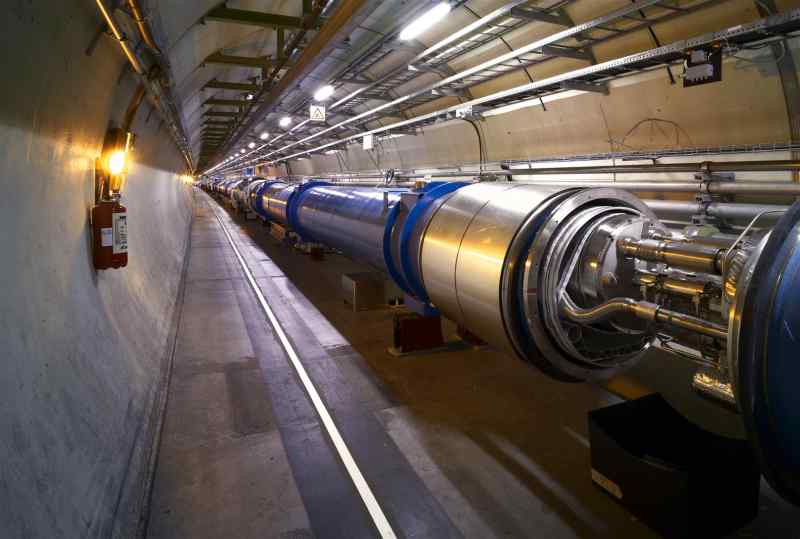 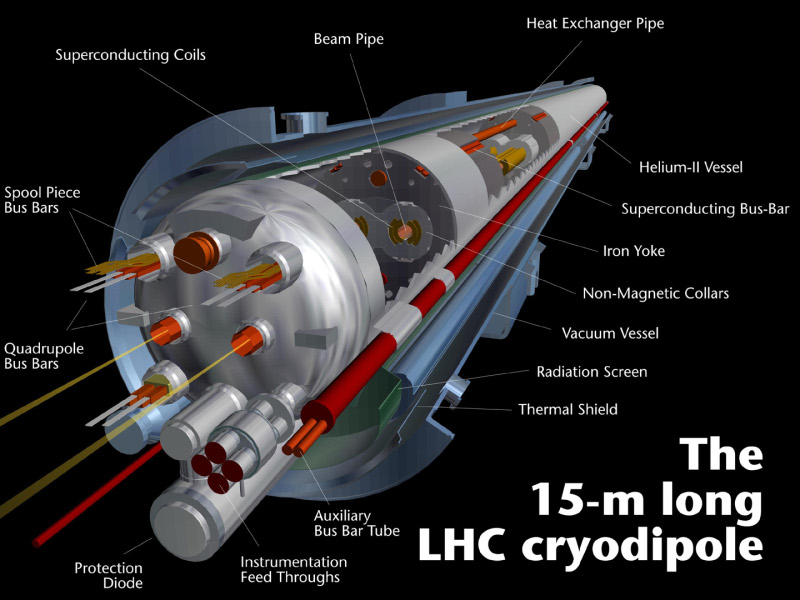 The LHC itself isn't much to look at. It consists of a lot (1232) of shiny blue tubes about the diameter of a car tyre attached end to end around the ring, situated 100m or so beneath the borders of France and Switzerland. These are the superconducting dipoles, which is a fancy name for what is essentially a big magnet. Inside these blue tubes are the beampipes, sitting side by side and surrounded by liquid helium and superconductor. The superconductor needs to be kept cold to operate, and holds an enormous electric current creating a strong magnetic field. This field is what holds our protons inside the accelerator. As the protons travel around the ring they get flung outwards like a kid on a playground roundabout. The magnets provide the nudge needed to stop the protons flying out from the ring in a straight line and burning a hole in the side of the beampipe. At four different locations on the LHC are 'interaction points' where we bend these two beams together much like the crossovers you see on toy car racetracks. At these interaction points the two beams collide smashing individual protons together unleashing vast amounts of energy in a very small space. This is where we hope to witness some things humankind has never before seen.... The Experiments of the LHC There are four main experiments, one at each interaction point. These are the real beasts which everyone has probably seen photos of by now. What the hell though, I'll throw in some more. ATLAS 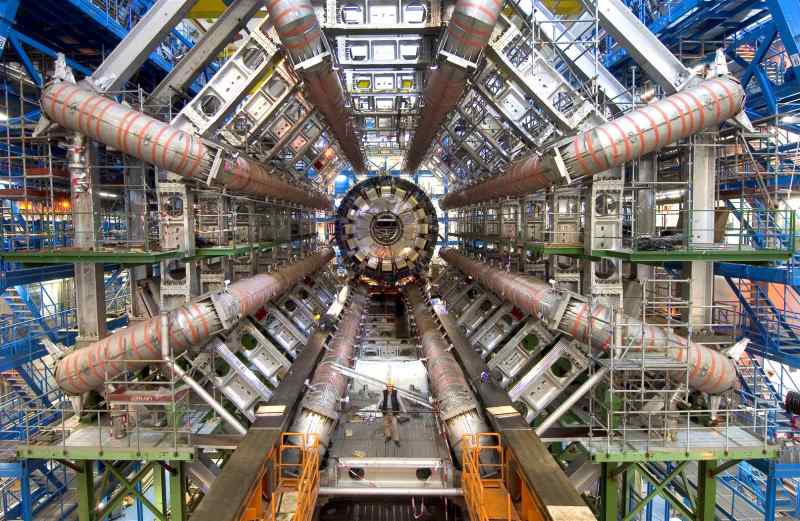 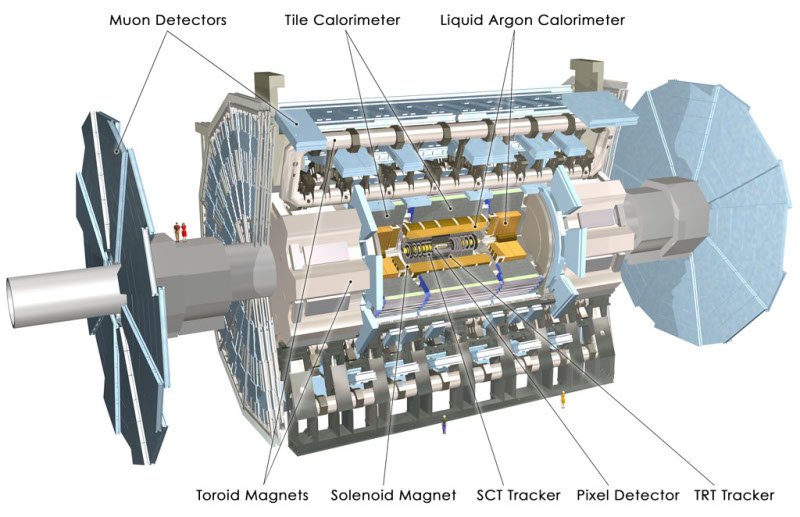 ATLAS is A Large Toroidal LHC ApparatuS, and is truly a monster of a machine. The biggest of the big experiments, she is as heavy as 100 jumbo jets, and fills a cavern capable of housing Notre Dame cathedral. CMS 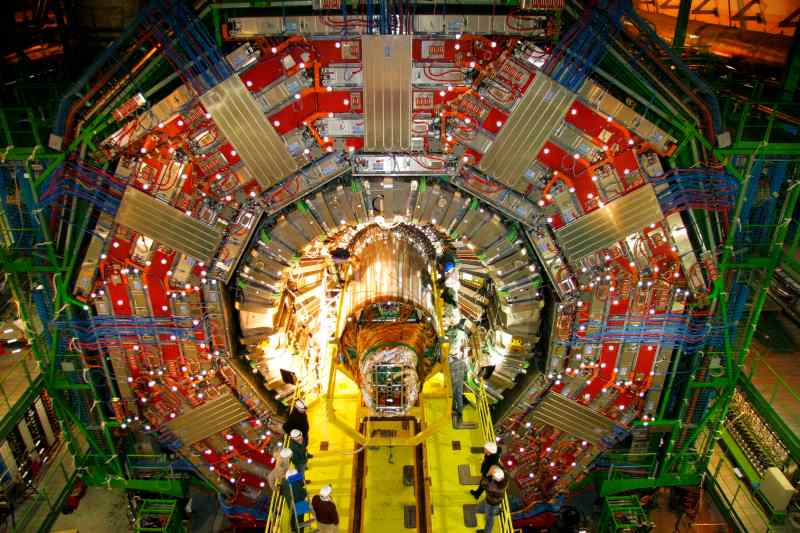 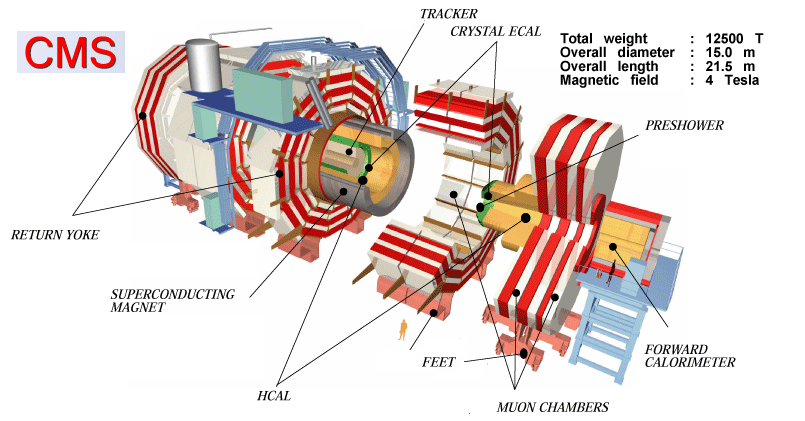 CMS is the Compact Muon Solenoid... compact? I think not. It is the heaviest of the experiments at over 12500 tonnes. This is mostly because it has to generate a large magnetic field deep within the detector- the superconducting magnets use an iron return yoke made from the hulls of old russian battleships (no joke!). LHCb 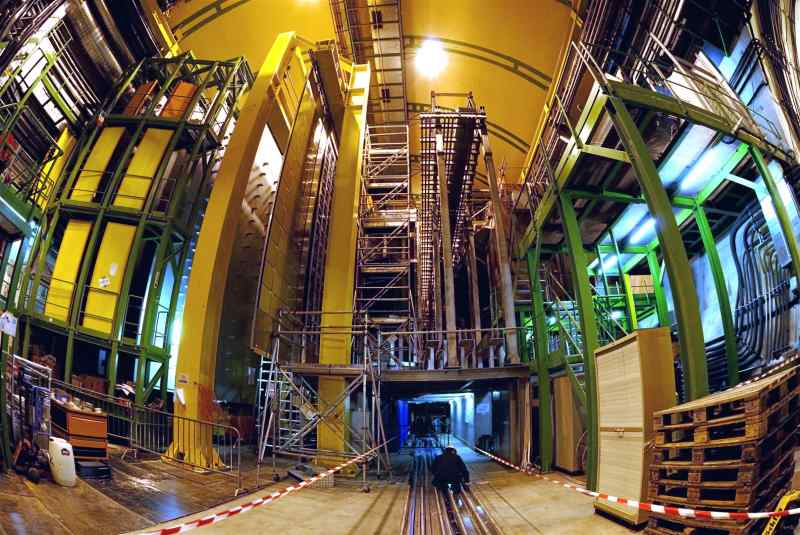 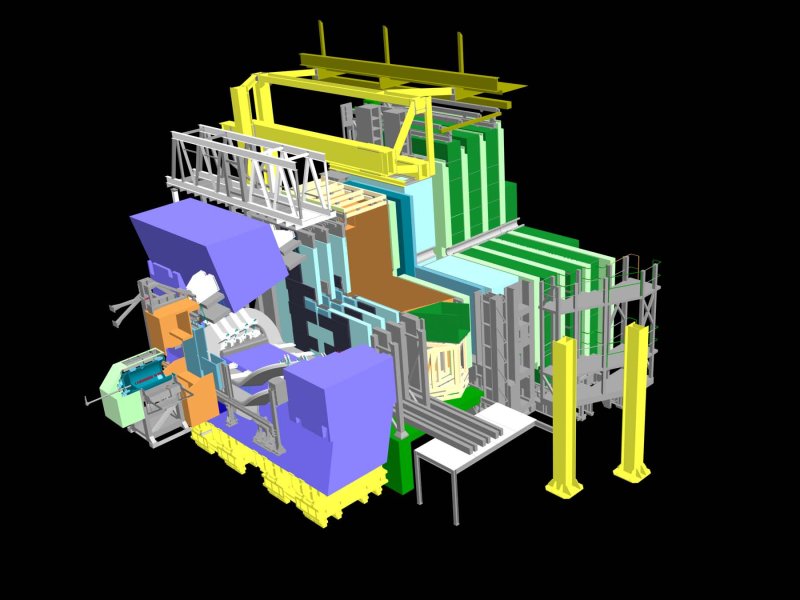 LHCb is the boringly named Large Hadron Collider beauty experiment. This is the one I work on, and the ugliest of the bunch. I don't know who the hell chose the vomit yellow and green coloring, but the detector itself is beautiful to work with. She's the smallest of the experiments, both in terms of material and researchers, but she's also the most precise, capable of measuring with far higher accuracy than the others. ALICE 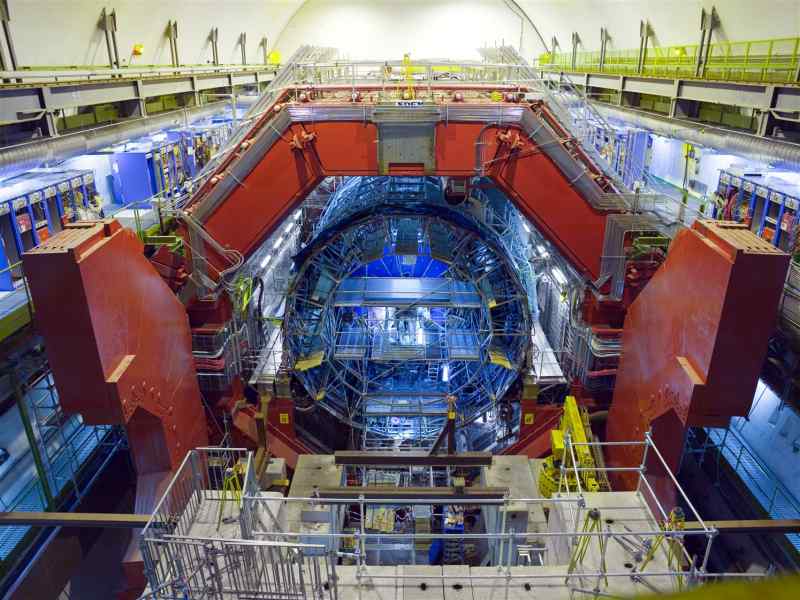 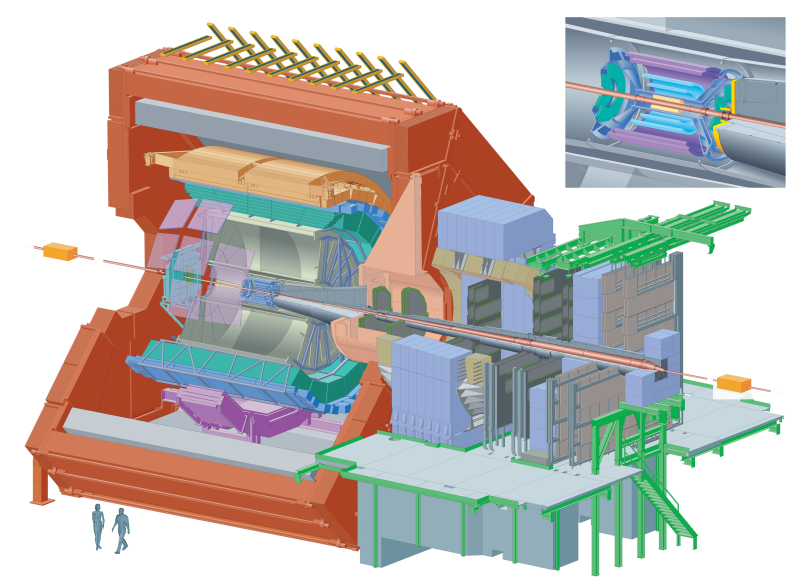 ALICE is A Large Ion Collider Experiment. Rather than looking at protons, ALICE is going balls-to-the-wall and looking at lead ion collisions. This is the equivalent of slamming two elephants together at a few hundred miles an hour and trying to understand the mess, in comparison to the protons used in the other experiments. So what are the experiments looking for? The four experiments are each looking at very different things: ATLAS and CMS are 'general purpose' detectors, and are concentrating on looking for the Higgs boson (more on this later), but also looking for signs of new physics and lower resolution studies of the things LHCb and ALICE are looking at. The LHC was primarily designed to find the Higgs, so the two detectors add some redundancy- if one doesn't find it, the other can still do so. LHCb is trying to tell us why we're made of matter. Sounds like a stupid question, right? Actually it is a bit of a head-scratcher. The Big Bang is now favored as the model of the creation of the universe. It predicts very well a number of phenomena we can measure accurately enough to tell us it's right. It gets it wrong somewhere important though, and that is that our models tell us matter and antimatter were made in equal amounts at the dawn of the universe. We can measure how much antimatter exists now, and it is several billion times less than the amount of matter in the universe. The thing is, this shouldn't make sense- if the same amounts of matter and antimatter were made, and they mixed with each other, they'd annihilate again leaving nothing behind. The fact that there was less antimatter than matter is the reason we exist today, but we don't know why. The LHCb will give us a deeper insight into this. ALICE is trying to simulate conditions immediately after the big bang, slamming heavy lead ions into each other and releasing so much energy in such a confined space that the temperatures soar to those many thousand times hotter than our sun. Immediately after the Big Bang, all the matter in the universe was crammed into a spot a lot smaller than a pinhead, and the conditions there are like something that we cannot find in our universe today. Strange states of matter are thought to have existed at these temperatures, and ALICE will probe them for a better understanding of the formation of the universe we see today. So how do you detect all these crazy particles? What does it 'look' like? At the interaction points within the detectors, our protons slam together turning into pure energy. Einstein's great equation tells us that energy = matter, so if we have enough energy, particles can be made from it. What particles are made depends upon how heavy they are. These new particles, most of which we have seen before, are usually unstable and decay into even more particles. The direction they shoot off in, their mass, speed, charge, and what they decay into make a 'signature' telling us what the particle was. The big detectors are actually made up of thousands of smaller detectors, much like a digital camera is made up of a few thousand light sensors. In fact, much of the technology in a digital camera is similar to the silicon detectors most of these experiments use. Light is after all just a bunch of photons, a particle we measure all the time in these interactions we study. Different subdetectors measure different things- calorimeters measure energy, trackers measure the path a particle takes as it flies through, and vertex locators tell us where the particle was born. Putting together all this information is a tricky task- in your digital camera each pixel gets read out and saved to the camera memory to make an image a few MB in size. Our detectors do the same. We take a picture and each subdetector that saw something gets read out to disk forming an 'event'. This event can be a terabyte in size, and we take a picture 40 million times a second. This would be impossible to store, but much like going through your camera and deleting the crap shots, we have what is called a 'trigger'. The trigger is a whole bunch of computers that look at the event to see if anything interesting happened. Most of the time the photos are just noise- things we have seen before and have told the trigger computers to ignore. Once in a while however, we'll see something interesting. This gets sent along the tunnel from the experiment to CERN's computing centre where it is reconstructed. Reconstruction is turning the event that we have captured into physics. Basically the event consists of a load of information from the electronics like 'This subdetector saw this voltage in this sensor, This other subdetector saw two hits in these two locations'. Reconstruction turns that into 'a Kaon was spat out of here at almost the speed of light, it flew along for 1.47 nanoseconds and then decayed into two pions'. It is here that we get the pretty pictures: 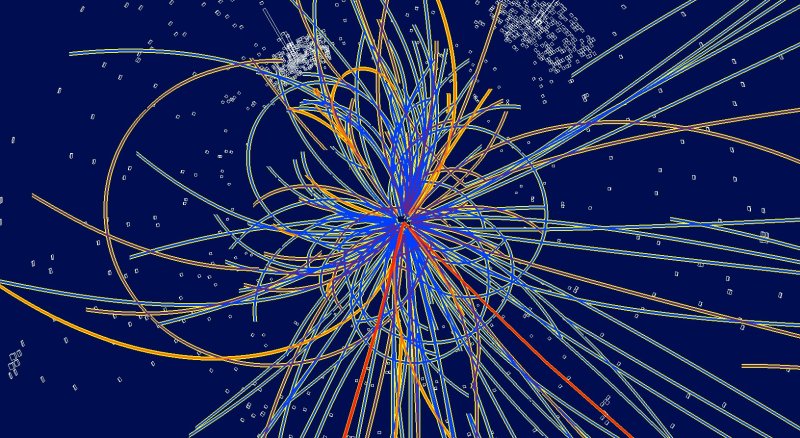 This is a simulated higgs event in the CMS detector. The different coloured lines are different particle tracks, while the white squares are energy deposits in the calorimeters. The reason the tracks are 'curly' is because the inside of the detector is a strong magnetic field. The particles bend in this field, and how much they bend tells us what type of particle they are. By capturing many, many events like this, we can form an idea of what is going on- what particles are decaying into what other particles, and how often. If we measure an absence of energy, we know something is happening that we can't detect. This is one of the fingerprints we are looking for, signs of new particles we have yet to observe.... So will the LHC Kill us all? Is it dangerous? 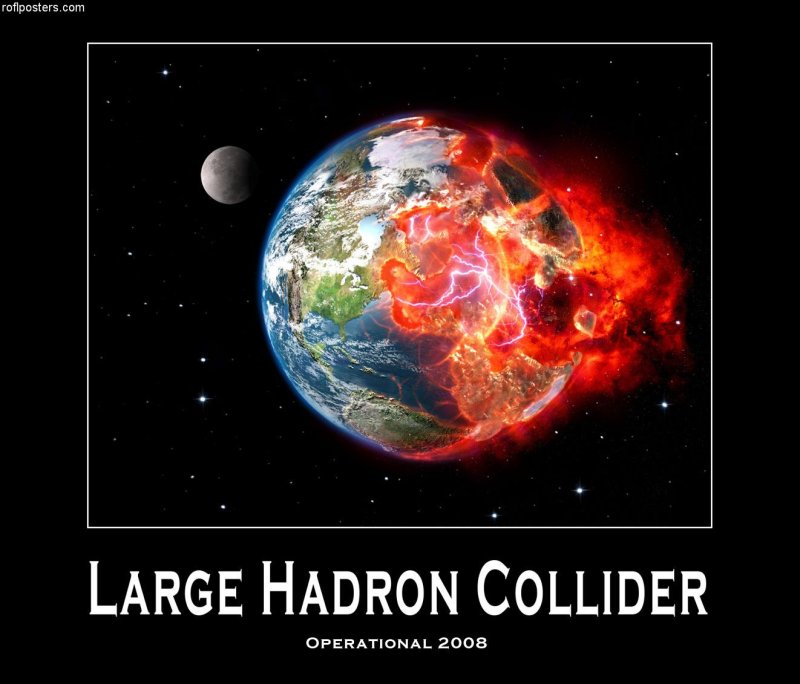 No. The LHC is going to produce things physicists have never before seen, but in a lot of cases we hope it will produce things we've predicted. Recently a number of somewhat unsavoury attention whores have misled the media and general public with a campaign based on the possibility that we may produce something truly dangerous. There have been numerous arguments against these 'doomsday scenarios', all from physicists a good deal smarter than me. Here is my take on the subject though: It was originally considered that the LHC may produce micro black holes. These would be black holes smaller than atoms. Of course, knowing that a black hole is not something you want to get too close to, this drew a lot of scaremongering. The truth is that black holes must be produced at a certain size before they are capable of growing on their own by attracting more matter. That size was estimated in a recent paper to be larger than the mass of our sun. Anything smaller and they just sit there evaporating until they are no more. The smaller the hole, the faster the evaporation. We expected anything the LHC could have produced to live for a few femtoseconds before disappearing. As it turns out, another recent paper provides convincing proof that black holes are not likely to be produced at the LHC at all.... There are other supposed dangers, namely magnetic monopoles and strangelets. In both cases the theory on which these exotic forms of matter have been based is a little crackpotish, and numerous conterarguments have been put forward. To paraphrase Prof. Frank Close of Oxford University's High Energy Physics dept, "The LHC isn't going to end the world. If it does, you can sue me." When will the LHC start? This morning, CERN made official a start date that has been bouncing around the detector caverns for a while now- 10th Sept. 2008. This is the inauguration day, and it is expected that a couple of protons will be ceremonially thrown around the rings, but not collided. The first collisions are hoped to come in October. There is now an official countdown on the CERN Website, NOT lhccountdown.com. That site is run by a /b/tard. Get the real countdown here Why did it take so drat long to build and start? The LHC is absolute state-of-the-art. When it was designed in the late 80's through to the 90's people actually used moore's law to work out how much computing power would be available for the experiment come runtime. That is how far-thinking they were at the time. There have been one or two minor technical glitches along the way, but the thing that really takes time and which can still shaft us is the cooldown of the dipole magnets. These are pumped full of liquid helium and cooled to 2 kelvin- colder than space! It takes several months to reach this temperature, and if anything goes wrong it means another 2 months while it is cooled again. Each sector of the LHC on this image is now blue, indicating cooled status. This has been going on for a year now. 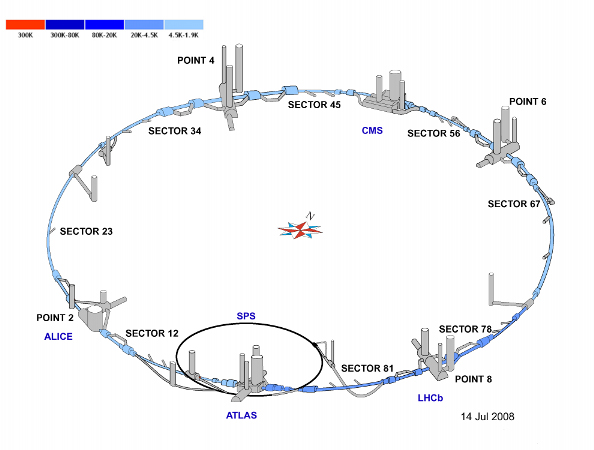 That's it for now, I'll add more to this as time allows, and I'll try and explain more about what we're looking for and why in a post tomorrow. I'll also try to answer any questions you may have, and keep you updated with the status of the LHC as time progresses. It is a very busy time for everyone involved in the LHC for obvious reasons, but it is also an amazing time to be involved in this piece of scientific history.
|
|
|
|

|
| # ¿ Apr 19, 2024 11:21 |
|
Cheesemaster200 posted:How the hell is this thing powered? Are there generating stations on site? Whats its total power consumption once it comes online? A great first question! The entire complex is powered courtesy of the French. They generate the majority of their electricity using nuclear power, and the thing about nuclear reactors is that they are 'always on'. If you use 100MW of power and it puts out 400MW, the rest usually goes to waste. In the summer people tend to use less electricity (Europe isn't as A/C heavy as the US, but we still heat in the winter) so France doesn't use all their power- we only run the LHC in the summer months, and shut it down for maintenance in winter. I don't have an exact figure for power consumption, I'll have to look that one up. It is a pretty scary figure though if I recall correctly.
|
|
|
|
prawnsy posted:I have a stupid question! Is it possible to somehow fall into this thing? And if you did when it was doing it's thing, would it just wreck you? Or is the place relatively safe for the people working on it? You see the top photo in my post, the yellow door I'm standing in front of? That is a safety door- If it is open, the accelerator shuts off. When we work on the experiment we need to take a key from a whole rack of about 50 keyholes in the wall nearby. This is the only way to open the door, and while the key is removed, there is no beam. This ensures no-one is down there during the running of the detector. The thing is though, while the accelerator is running, it spits out particles at such speeds they irradiate the stuff they hit. Usually after running the caverns are 'hot' for a while, and we need to wait for radiation levels to reach safe values. While working down there we carry dosimeters to monitor how much of a nuking we get. The beam itself could spectacularly gently caress your poo poo up if you got in the way of it. It has happened before on russian accelerator I beleive, using a far less powerful beam. Surprisingly the guy survived it. With the LHC the only thing that'd survive would be a lingering aroma of evaporated geek.
|
|
|
|
HarryLerman posted:What do you do in the experiment, and what is your education Another good one- at this rate I won't need to post my own follow-ups, as this was one I was planning on writing up too. I'm essentially a bitch. A Gordon-Freeman in Half-life 1, if you will. I Just graduated from an MPhys (hons) at the university of Edinburgh, and I've started my PhD as of May. For the last 3 years I've been spending my summers working on the LHCb experiment- 2 years ago at Edinburgh calibrating and testing photon sensors for the RICH which is a subdetector of the LHCb, Last year at CERN studying the effects of Cherenkov gasses in the same detector, and this year writing a paper on the sensitivity of the LHCb to a certain decay. I started at undergraduate level, mainly because I knew I wanted to do this since I started my degree. I wandered into one of my supervisors offices and asked for a studentship. Since then, I've been sweating blood for them and loving every minute. It paid off, as the PhD interview basically was a formality. Throughout the PhD I will most likely be working on characterising the Hybrid Photon Detectors of the LHCb, analysing data as it comes in, and working on the upgrade of the detector in later years.
|
|
|
|
NoCleverName posted:What country are you originally from and do you have to live near the collider while you work with it? I'm Irish, born in Belfast. I study in Edinburgh, Scotland though, and I'll be spending at least a year living 'on site'- usually in the small town of Meyrin which is right on top of the detector. Stopping the beam is pretty cool- There are 'beam dumps', one for each beam, sitting on a junction off the ring. These are massive blocks of carbon surrounded in concrete and cooled with water. In case of an emergency, battery powered 'kicker' magnets kick the beam out of the ring and along to the beam dumps. The energy released as the beam slams into the carbon is enough to raise it to several hundred degrees, and the beam must be moved in an 'e' shape around the block to stop it from burning one place only.
|
|
|
|
Stupid_Sexy_Flander posted:How strong of a magnetic field should/does this thing put out? I am wondering if it is something along the lines of "Don't wear metal past this point" or "Holy poo poo some dude in Belgium just lost his fillings". I am not a particularly brilliant scientist but I have played half life and half life 2, so I think I am qualified to think "If it can create black holes, then it's gotta be one hell of a magnetic field". The magnetic fields involved are enormous, we're talking several tesla, on par with and stronger than most MRI machines in hospitals. The thing is, in the LHC this is confined to the blue beampipe which acts as a cage (They hosed that up in T3, the field outside the pipe is not that high). The experiments however, generate large fields in open spaces. There is a story that the CMS detector held a large residual field even after shut-down, and it tugs at belt buckles as you work on it. As for resonance cascades- someone put up a big red 'black hole abort' button in the CMS cavern....
|
|
|
|
The Artificial Kid posted:Now I'm not saying the LHC is dangerous. I expect it's safe. But that is a dick argument. Just because nobody will be around to know or sue if it goes wrong, doesn't mean it's an unimportant question. It's like he's being a juvenile solipsist, and taking it upon himself to be that way on behalf of all of us instead of doing his level best to clarify the issue for people who don't have ten years of physics education. You're absolutely right, it would be a dick argument, but he said this after discussing the fact that many, many papers have been published in recent months dismissing the possibility. I agree that it is a very unscientific answer, but many physicists find it hard to respond to these questions because it would be asking a fish if bicycles are an effective form of underwater transport. I guess as scientists we're guilty of not trying harder to educate the public on what is and isn't science, so we tend to come across as condescending when we are dealing with people who have been misled. It is like wondering if someone is trolling or not. As for the Karl Pilkington comment, have you ever seen me and him in the same room? Just sayin', he might have gone ton night school... Fusion- not my area of expertise I'm afraid. I was at a seminar last year that suggested '50 yrs before it reaches commercial reactors' but I suspect more money will be put into it now that oil is truly hosed. Perhaps a speedup is on the cards? Lastly- Well spotted on the LHCb. The reason it is such a different shape is because the particles we are interested in tend to exit from the collision at an angle very close to the direction of the beam. The other experiments are looking around the entire collision point, in a cylinder. We are looking only at stuff spat out in one direction, at a narrow angle. Out 'proton hole' doesn't exist as such, as the collisions actually occur at only one end of our detector. They occur in the center for the other experiments.
|
|
|
|
ReV VAdAUL posted:Thanks for posting this, I have a semi-serious question, are there any likely everyday applications the results from these experiments will have? I imagine that if so its only very indirectly but I love the idea of something along the lines of "our washing machines are now 30% more effective thanks to LHC research!" Another commonly asked one- There are almost no direct every day applications from the work we do. In your home right now, there are at least 3 pieces of particle physics you use frequently, the smoke detector, the microwave, and the Cathode Ray Tube TV. Those are all old inventions though. The problem is the energies we deal with are just not possible to make on a tabletop yet, and even if you could, you'd not be able to do much practical with them. The cool part however, is that there are many indirect applications. The superconducting cables we use in our magnets save insane amounts of electricity. They're being tested in the US at the moment as underground cable for long-distance transmission of HV. The web is ours as well, invented at CERN by Tim Berners-Lee as a tool to help us shuffle data around universities.
|
|
|
|
lapse posted:I imagine that the entire machine has to be almost exactly perfectly round for the beam to not smash into the outer wall of the solenoid thingy. (maybe that's wrong?) How do injection points and collision points work so that the beam can be shifted without smashing into the wall of the machine? You're right, in that the beam smashing into the outer wall would not be a good thing. However, the dipoles you see are actually straight instead of being curved. The magnets are tuned at different field strengths and varied extremely precisely to contain the beam. This is all automated and a string of sensors around the beampipe monitor and make adjustments in nanoseconds.
|
|
|
|
Bonk posted:A few for you: It is a combination of the two- We're deadly serious when it comes to our work, for obvious reasons, but we also see the funny side. I guess it is the same as in any job, but there is quite a bit more geek humor. The general attitude I think is along the lines of 'we are doing this because we love it, seeing as there sure as poo poo isn't much money in it.' and as a result people are generally happy in their work. Bonk posted:Assuming you understand the results of this thing, what do you use it for after that? Does it have any theoretical applications or is it strictly to observe the matter's behavior? There are a number of possible outcomes from this experiment, I'll list them in order of shittyness: - We see the higgs boson, and Nothing else. This would really suck balls, as it pretty much ties up the standard model, and says 'that's all folks'. It puts us experimentalists out of the job, and leaves theorists without much to do either. - We see Noting at all. This isn't as bad as it sounds. It means the theorists are left with a lot of explaining to do, and it means the experimentalists can say 'The theorists hosed up, we need a more powerful machine to find their improved theory' - We see the Higgs, but not quite where we expected it. This is a good sign of 'New Physics' which we capitalise and call NP in our presentations. It is a way of saying 'gently caress yeah, something is going on and we don't understand it yet. There's gold in them hills, lets get digging'. - We see something completely unexpected. See the previous point, but with the added headscratcher that higgs isn't in there. The LHCb is doing exactly what you suggest, in that it probes and constrains the possible theories that exist right now for CP violation, the theory behind why we think the universe is mostly matter.
|
|
|
|
Phy posted:This is why one pays ten bucks to post on an internet forum. The difference between a PPE and a PPT (particle physics Experimentalist/Theorist) is that PPE's work for a living  Actually, the PPE's tend to be jack-of-all-trades, masters of none. To do my job I need a good knowledge of electronics, statistics, power engineering, programming, design, theoretical physics, applied physics, chemistry, engineering... The list goes on. We have to design and build these experiments, as well as running them, and deciphering the physics from the results. The theorists are in general far more specialised, and tend to work in an office stacked with papers to read, their tools a pen and paper, or chalkboard or computer. The PPE has a much more diverse career ahead of himself, but tends to be pretty thin on the ground. As for the higgs mass question, LEP set the lower limit, and the mass of the top quark constrains the upper limit, if I recall. If it is above the proposed upper limit, it'd be difficult for the higgs to couple to anything in the standard model. There are a number of theories though, depending on the type of Higgs (there's more than one). To go any further is beyond my knowledge though and you'd need a theorist.
|
|
|
|
Kaiho posted:Excellent, well-written and thoughtful thread. Thanks for starting it. I'm glad you write with a clarity of expression suitable for us not versed in physics, and am equally glad you told the neckbearding theoretical physicists to stay the gently caress away. Sure thing- http://arxiv.org/abs/0807.1938 The arxiv hep-ph preprints are an awesome place, often they are far too theoretical for me, but there are often a few gems in there. For a more friendly and often entertaining look at what we do one of the better reads is cosmic variance.
|
|
|
|
GoatSeeGuy posted:Since people have been working on putting together the LHC since the 80's have they already started designing the next biggest, baddest particle accelerator on Earth or are they waiting to see what the LHC can do before planning LHC2: Electromagnetic Boogaloo? First off, "LHC2: Electromagnetic Boogaloo?" is easily the best name for the upgrade I've ever heard. I am putting that up for nomination. The LHC2 is called the 'Super LHC' at the moment, and is planned to come into effect in 5-10 years assuming we have the cash. It isn't a complete rebuild, but it'll be a lot more powerful than it is right now. The detectors will be beefed up too. The idea is that the longer you run an experiment for, the less improvement you get. Eg: running for one year nets you a result, running for two nets you a really accurate result. Running for 4 doesn't get you much more than you got running for 2. By beefing it up and doubling the rate, you keep on top of the particle physics equivalent of Moore's law. The SLHC is well into the planning stage, and my experiment is already looking into new designs and components before it has even started. In addition, the ILC was planned to take up the gauntlet, but because the US and UK pretty much dropped it, us PPE guys are scratching our nuts as soon as the LHC ceases to be useful. We need to find something juicy to keep ourselves in business.
|
|
|
|
Alex007 posted:Fantastic thread, very well written, lots of awesome information to read, thanks a lot for this ! Protons are in fact Hadrons. The wikipedia article is pretty badly written, so here is a better idea of it. Hadrons are made up of quarks. That is pretty much the definition. The thing is that there are two types of Hadrons: Mesons and Baryons. The proton is a Baryon, so it goes: proton = a baryon = a hadron.
|
|
|
|
err posted:How many buttons are there to turn it on? Who gets to press them? This is the 'button' http://www.youtube.com/watch?v=Jy2179DcNT8&feature=related The CCC or Cern Control Center. each of the 4 'islands' deals with a different stage of the LHC. The injectors, the initial accelerator called the SPS, the LHC cooling system, and the LHC itself. It requires on average about 40 staff to monitor, control and diagnose just the beam. The detectors will have a similar number of staff themselves in each of their own control rooms monitoring their experiments, and all are interconnected so that if a detector sees a problem with the beam, so does the CCC. To actually inject the beam, accelerate and collide will be pretty much automated as the timing is much too fast for human error, so it will probably be achieved with a couple of mouse-clicks.
|
|
|
|
BklynBruzer posted:What I'm wondering, Starking, is how much (if any) kinetic energy these beams might have. At those speeds, I imagine that even subatomic particles would be pack a bit of a punch. Another good one- the 'energy' of the LHC beams is measured in TeV, or Tera electron Volts This is the kinetic energy of a proton in the beam. If you type into google "14TeV in joules" their calculator will do the conversion for you. It is a very small number, but then you must also consider that the proton is extremely small. It is roughly equivalent to the energy of a mosquito in flight if my memory serves me, but compressed into a space 10^26 smaller than the mosquito. It is enough energy to heat up a few tonnes of carbon beam dump to a couple of hundred degrees, so I'd say a punch is an underestimate!
|
|
|
|
my2k posted:Do you know the girl who made the CERN rap? Because that poo poo is dope as gently caress. I'm listening to it right now and I might or might not know all the words to it. The behind the scenes photos are best found by googling, to be honest. The nice thing about CERN is that it is an international, publicly funded organisation. The work we do is in essence free for the good of humanity. There are copyrights, but the information itself is available to all. If you check out CERN's document server, CDS, it has all the photos ever taken at CERN. 
|
|
|
|
Happy-Fun-Ball posted:If all the matter in the universe was in such a tiny space at the beginning why wasn't it a black hole? The density was enormous, but so was the energy. Essentially it would be like the first few nanoseconds of a nuclear explosion. Vast amounts of matter/energy confined in a minute space, but itching to release itself into the infinite void of its surroundings.
|
|
|
|
narby posted:What's to stop the two colliding beams damaging the equipment that's supposed to detect the results? If you use giant carbon blocks to stop a single beam, what prevents all that energy doing damage? The beam is only doing damage as long as it is hitting something. The rest of the time it is contained in vacuum, guided by strong magnetic fields that keep it off the walls. The detectors don't go near the beam, they detect the things thrown off at the interaction point. The closest thing to the beam in the entire LHC is part of my experiment, called the VELO, short for VErtex LOcator. It sits 8mm away from the beam, and we are worried it can be damaged, so we have it sitting on a retractable shelf that slides out until the beam is stable.
|
|
|
|
Gordon_The_Fish posted:Just how many PhDs do you think will be earned from all this? Very many indeed. There are some 7000 researchers involved, a good chunk at the postgrad level. In Edinburgh our group is pretty small, but already at least 6 students have gotten PhDs from it, and another 3 are due to submit this year. I'd say by the time it is done and dusted, there'll be a thousand or so PhDs from it. That excludes the upgrades.
|
|
|
|
Griffen posted:Hey StarkingBarfish, a few questions if you don't mind. In the LHC, we collide one proton into another. It isn't a 'fixed target' machine. To do this, we need to send a bunch in one direction, and another in the opposite direction. Hence the 2 beams. Griffen posted:2. How do you ensure containment? I know that even with decades of work into the tokamak they still have issues with energetic particles escaping confinement, so much that they are working on using liquid Lithium walls with a kind of filter to pass the fuel back in. Even then, tokamaks usually operate in the 100 keV range, and you have to be at least in the 10's of MeVs, right? Especially since your beam is self-repelling, or at least I'd imagine it to be, confinement must have been an issue in the design. We're operating in the TeV range... but we're operating in that range in an intentionally uncontrolled manner. Essentially in a Tokamak, you are trying to confine the particle interactions so that nothing leaks out. What we are doing is slamming the protons together with the intention of the particles they create flying outwards so that we can measure them. They then leave the detector completely and decay into stable particles. In the beampipe our beams are 'cool'. All their energy is directed along the beam, and the magnetic fields don't need to work against this 7TeV, they work tangentially to it, pushing the beam into the ring. The energies needed for this are much lower, so containment within the beampipe isn't a problem. The LHC and a Tokamak are very different beasts- one is trying to harness the energy to use, the other is trying to release the energy to study it. Griffen posted:3. Along that line, how are you generating such an energetic beam of pure protons? I'd imagine taking some hydrogen gas, ionize it, and have some anode or something collect all the electrons. However, I'm not sure how you guys come up with a means to generate those kinds of temperatures. Is it electrostatic, electromagnetic, wave based? I guess with a low quantity of protons you can just try to use a massive voltage drop with a power supply, but that seems difficult to make it work. Good question, and you're absolutely right. The LHC 'fuel' is a simple bottle of hydrogen. Here is a photo I took of it while I was there. This is beside me in the very first photo:  We do exactly as you say. The metal cylinder under the bottle of hydrogen is an electrostatic ioniser. We pass a few thousand volts through it, and it tears off the electrons. At the same time, another cathode ring at minus a few thousand volts drags the protons out into the beampipe of the Linac 2, the orange accelerator I'm standing beside. This then speeds them into 2 other acclerators prior to injection to the LHC. Griffen posted:4. The last one is more of a theory question, so I apologize in advance, but even if they find the Higg's boson, how will that explain how gravity works? I once read that in general, each force has a "working" particle so to speak. For electromagnetics, its the photon, for gravity it is supposed to be the Higg's boson, and for the weak and strong forces I can't remember. Then these "working" particles cycle between the two bodies interacting, or something like that. Either I was misunderstanding or that just came off as a giant hand waving argument. Does anyone actually have an idea why a force derived from a field is obtained by particles? The higgs doesn't tell us how gravity works- mass and gravity are two different things. I know that sounds weird, but to put it another way, you've heard of inertial mass and gravitational mass, right? It is a coincidence that they are the same value, but they are not the same thing. Essentially the higgs tells us how things come to have mass, but not why gravity attracts mass. As for forces derived from fields, this is really heavy going, and one I still struggle with. The idea is that these particles are 'virtual'. They can become real in certain circumstances, but in general it is a result of the theory. We require a messenger to carry mass, charge, and other quantum numbers between particles in an interaction, in the same way that a postman carries mail between houses. I'm afraid I'm really not qualified to offer a better explanation, but I'll ask a theorist tomorrow for you. It's something I'd like to know more about too. Griffen posted:A bit wordy, but these were some of the things that I find curious about the LHC. Thanks for filling us in with the behind the scenes scoop, I wish the US would get off its rear end and get back into high science. No problem! As for the US, I think it is a global problem right now. The UK followed suit not long after the US, and Italy is doing it too. I think the economy isn't healthy enough worldwide right now for research that doesn't yield instant return on investment, so we're suffering.
|
|
|
|
Ziir posted:What language is widely spoken over there? English? English is the spoken language, but everything is printed in French too.
|
|
|
|
Ziir posted:So what will you be doing as this is ran? Will you just sit in an office above ground watching your computer fill up with data or will you actually be underground doing something, and if so what? While it is running, I'll be a 'shifter', sitting int he control room, monitoring the beam, the detector, and checking that the data quality is good so that we can analyse it. In the summer during power-down I'll be all over that detector like a fly on poo poo, replacing parts, making adjustments, debugging code, rewiring, and getting a healthy dose of radiation... During my time off in the winter I'll be skiing in the mountains around switzerland, and in the summer cycling around europe. Basically my dream job!
|
|
|
|
gigawhite posted:Will there be a lever that a researcher can pull when they find the Higgs Boson that unleashes a crapload of confetti and balloons? I'm hoping on a lever that unleashes beer and hookers... I think the guys a few labs over are researching that. Actually, there will be a celebration, but we'll have to wait and see. I think it won't be anything spectacular, but the collective feeling of achievement will be electrifying.
|
|
|
|
golden_appel posted:Excellent thread, thanks for the time and effort you've put into it. You have a great way of explaining this stuff so that even a non-scientific dude like myself can grasp it. This is the one to answer! It is a pretty tough one. Basically, chemists have this amazing piece of science, the Periodic Table. It is mostly unchanged for the best part of a century, save for the addition of a few more elements slapped on the end. It is the cornerstone of chemistry, and is a 'map' of sorts that tells a chemist how an element behaves, what it is likely to combine with, how heavy it is, etc. Physicists have a similar map, called the Standard Model. This tells us what all the particles are, how they interact with one another, what their charge is, etc, and it does it very, very accurately. There is a problem though: We have no clue why particles weigh what they do. A good example is the proton. It's a hambeast, clocking in at 1000 times the mass of the electron. Inside it are 3 quarks, and each of these are pretty fat too. It is made up of two 'up' quarks, and one 'down' quark. The down quark is twice the weight of an up quark, but we have no idea why. The standard model as we know it will tell us if we throw two protons together, out the other side will come a whole load of different quarks, forming mesons, hadrons, leptons, it'll tell us what charges they will have, what their spin will be, whether they're particles or antiparticles, but it has no method of saying how much they will weigh. It's not like something is missing from the model, like a hole that says 'put mass calculations in here', it's as if mass just isn't part of the standard model. In the 60's, a professor at Edinburgh University, Peter Higgs, came up with a solution that permits this. The Higgs field. Particles that couple strongly to the higgs field are more massive, ones that don't are lighter. The maths comes out in a beautifully simple way, and that is often a sign in physics that the theory is one worth testing. Since then we've been looking for the higgs for years, but only now have we an accelerator powerful enough for it. The Higgs boson is the 'messenger' of the higgs field. When we collide, create or annihilate matter, particles sit between the initial and final states, transmitting information about a certain property between these states. In the case of electric charge, that is the photon. For the weak force it is the W+,W- and Z bosons, and for the strong force it is the gluon. Essentially, they keep track of what everything is doing and make sure it all adds up on either side. Example: We have a neutral particle, and it decays to two charged particles. In this case we started with 0 charge. If on of the final particles is charged, the other must have the opposite charge in order to add up to 0 again in the final state. This is mediated by one of these messenger particles. Sorry, that may be a bit long winded. I'll see if I can dig up a more coherent explanation for you for tomorrow.
|
|
|
|
squid carpet posted:I heard that CERN asked the band Spiritualized to play at the opening/start-up ceremony but were unable to do so, is another band going to be playing instead? This is important. I honestly have no idea. There will be a big press event, and I'm sure something will be put on for the public. I don't know what will be organised for it though. I'll be at the Scottish Parliament by the looks of it, telling them about why it is an awesome time to invest more in science and education 
|
|
|
|
narby posted:Are there any tours available of the place? Open days etc? It would be fascinating to see the thing up close There was a huge open day a couple of months ago, but I'm afraid it may be the last big one now that the caverns are in 'prepare for radiation' mode. We're now no longer allowed to take visitors down. There are a lot of above ground exhibitions, displays and tours organised for individuals and groups, but if you're like me, seeing cern and not the LHC caverns is like foreplay without the sex. That said, there are many more experiments running at CERN than just the LHC. There are plenty of very cool above-ground experiments to see too, and CERN's history is nothing short of spectacular. In my time there I've sat in a lecture theatre that once played host to Einstein, Feynman, Bloch, Countless others, and I've had coffee with no fewer than 2 Nobel Laureates. It is a pretty incredible place.
|
|
|
|
Kin posted:Maybe not as sciency as some of the other questions, but how loud will things be when it's running? This is a fun one to answer. Particle Accelerators 'sing'. They're actually very quiet as they contain few moving parts, but the vast amounts of electric current required to drive the magnets means that you draw huge loads on the transformer substations around the facility. When the beam is injected, the accelerator is ramped up- as the beam acellerates the field strength keeping the beam inside the ring has to increase just as you need to hold on tighter to a roundabout in a play park as it turns faster. This means the power increases, and you hear a steady hum increasing in pitch as the transformers pick up the load. The hum comes from the magnets, the cables, the transformers, anything carrying current. It is a wonderfully rich, deep hum, and it is unique to each accelerator, depending on the frequency of laps around the ring. It then steadies at max. beam energy, and drops quickly to zero as the beam is dumped. This happens over the course of a few seconds in the PS acelerator at CERN, and a little longer for the SPS. It is both haunting and beautifully impressive at the same time. I don't think anyone has recorded it, but give google a try 
|
|
|
|
Cyoktine posted:I can answer this question, if you don't mind (someone correct me if I'm wrong though). Thanks- a much more elegant reply than my own. To answer your own question: I've seen no protests, and no increased security. The site itself has always been pretty secure, but I suspect perhaps they'll take the precaution of bumping things up closer to the start date. The CERN fire brigade are pretty much the SAS of the safety world, they're the medics, hazmat squad and small army at CERN, trained to handle everything from all-out nuclear accidents to drunk summer students passing out. I reckon if a few nutjobs showed up with malicious intent they'd have a hard time getting past these guys.
|
|
|
|
Tempest815 posted:Oh man I love this thing. All my questions have really been covered, but for entertainment... How would you respond to this dude right here? Because that's sorta...the wackyness of the doomsday crowd taken to Crazyville. Wow, I've not seen this guy until now... He is thoroughly batshit. It's more frustrating when people have read things containing complex words others have said and repeat it ad-infinitum to you, because you can't explain to them why it is wrong until they are willing to listen and have described those same words. This guy however, you listen to him and about 4 out of every 5 sentences would be ridiculed by someone with even a grade school education. I genuinely feel sorry for him. I hope someone has taken the time to explain to him some basic science since he recorded this. I doubt it'd change his mind, but drat, it's worth a try. Edit: forgot to answer your second part. The current estimate for 'safe levels' is about a week after shutoff, but that'll increase the longer you run the collider for. Even after a week, we'll be limited in how long any one person can spend down there. If you went down immediately, you're very unlikely to do yourself any serious harm, but you'd probably get a hike in your life insurance premiums. CERN abides by the exact same occupational health requirements as those imposed on anyone else as to safe levels of radiation, and the current max dosage limits are very low with respect to long-term effects. This is all based on current estimates mind you- we monitor rad levels in the caverns, and the safety officer will only give the go ahead once they drop below those limits. If we've misestimated, we could be scratching our arses for a few weeks! StarkingBarfish fucked around with this message at 02:20 on Aug 8, 2008 |
|
|
|
935 posted:Is there some blog that will explain in dumb english the results of the experiments? I'd say the right mix between honest science and a plain english slant will be the likes of CV. It can sometimes get a little bit too theoretical in the comments section, but usually the blog posts are clear and concise. The writers have their heads screwed on.
|
|
|
|
The Pharcyde posted:This thread totally made my inner nerd go all I'd be the first to say that it is an astronomical fuckton of money to spend on only 4 experiments. It's something like $12bn US. The thing is, it isn't only 4. It is 4 multipurpose experiments each looking at very different things, and the data collected is likely to tie up a number of holes in physics. This alone doesn't sound great, but then you look at how the money is spent: Let's say the US donated $4bn to the fund. That means that $4bn was used by cern to hire in US construction staff, engineers, electronics manufacturers, software designers, etc to work on the machine. The money contributed to CERN is requred to be proportionally spent on labor and materials in the countries that contribute. In addition, CERN had to hire train, insure and pension researchers from the US proportional to their contribution. Many PhD students don't continue in particle physics- they go back home to work in biophysics or medical physics, where they earn a lot more. Then there's the ones who do stay in physics. These guys are seconded to CERN from universities proportional again to a countries' contribution. These lecture whole new generations of scientists. Last but not least, there are the knock-on benefits. Particle beams are now being used to treat cancer in a much safer, more controlled way than radiotherapy was used. It has many, many knock on effects that you don't see. It surprised me too- I'm doing it because I enjoy it, but hearing that there's all this behind it too means I feel abit less selfish about loving what I do.
|
|
|
|
The Pharcyde posted:Forgot to ask this one in my first post but I'm sure its going to come up at least 30 times so I might as well get it out of the way since its been mentioned in a lot of media regarding this for a long time and its really easy: I'm afraid not- This is a mix-up between the accelerator at SLAC in the US. It is meant to be straight, but had to be dug downwards slightly into the earth to account for the curvature. To the human eye it looks curve because it's surroundings are what we perceive as flat. The LHC very definitely looks curved as you stand inside it. You can see it in one of the pictures in my first post, but it is clearer if you are standing right up against the dipole.
|
|
|
|
Three Olives posted:There is a guy in my building that latches on to me and bores me to death every single party we have about his work on the super conducting super collider. A quick wikipedia search says that the super conducting super collider was actually supposed to be much more powerful the one you are working on. drat, I wish that was me. Maybe if I lost a few pounds, but lunches at the CERN restaurant are pretty much top-notch French cuisine.... The SSC would have raped the LHC, then flipped it over and raped it there too. The collider itself was far more powerful than the LHC designs. The thing is, the collider isn't technologically that impressive. The superconducting aspects of it are, sure, but we know just about enough about that area of technology now that the real challenges aren't 'how powerful can we make it' but more to do with 'can we make it small enough/cheap enough'. The detectors are the real issue. If the SSC had been built, the level of sophistication of the detectors, the computers needed to process all the information and store it, and the electronics reading all the data out to computer would have been a bit more antiquated than on the LHC. You have seen how quickly consumer computer tech changes, and the same is true for the computers we use. The thing is, they'd upgrade after a few years too, so my guess is, the US missed the boat on this one. I think it is fair to say that we'd have still built the LHC, but we'd not be able to claim to be the first with a real chance at the higgs.
|
|
|
|
mintskoal posted:This is an amazing thread to come home from work to read. Thank you so much for making this and putting it into verbiage that is easy to understand. The great thing about CERN is that it exists as a framework for physicists to collaborate in. In general, there are set procedures in place for coordinating the groups, for having big detectors moved about and that sort of thing. The idea is to let the geeks do what they do best, and take care of the political organisation and manpower via the council and the structure surrounding it. That isn't to say it isn't political. A lot of the time there is bickering over funding, hierarchy, that sort of thing, but when it comes to the physics, it tends to be completely apolitical, and totally enthusiastic. The decisions are in general made by the CERN council, a bunch of elected, revered scientists and the occasional rear end in a top hat diplomat who meet and democratically decide the running of CERN. As for technical challenges, I'm small fry, but I've seen my fair share of showstoppers. The detectors I was testing were prototypes, never before made, and we were putting them through their paces to make sure they matched our requirements. It turns out they're leaking vacuum- tiny amounts of Helium in the air are leaking into them through what must be molecule-thick holes and royally loving them up slowly. We're trying to work out a fix with the manufacturer, but they are almost out of warranty. If we can't negotiate something with them we may be in for an unpleasant surprise.
|
|
|
|
Robot Lincoln posted:So, what's the preferred method to get around this thing? Would an electric golfcart or a segway create too much interference? Official CERN bikes. Look like poo poo, squeak like poo poo, but like the rest of CERN, will keep running, apocalypse or not.  Not because a golf cart would cause problems mind you, more because CERN is pragmatic- they spend the money on the experiments, not on the luxuries. There are a few electric cars for emergencies, moving heavy stuff, etc. There was even a monorail a-la half life albeit much smaller, but that got removed to make space for the additional cooling and cryo lines.
|
|
|
|
Three Olives posted:Quicker, maybe if, apparently it exists at all. We sent over 4 billion dollars for what amounts to an uncompleted tunnel with as far as my understanding is no actual scientific equipment. I can only guess that the actual cost would have been astronomical. I'm wondering if we you think we actually really missed out from a scientific standpoint or a economic standpoint. From an economic standpoint, I'd say the LHC is a better deal because the cost is spread over many more countries than the SSC was. From a scientific standpoint I'd say the US lost out on exclusivity, but that means little these days. The physics community doesn't really live off national identity, it lives more off team spirit, so if you had american guys working at the LHC, and the SSC found the higgs first, the LHC americans would be pissed they'd backed the wrong horse just as much as the europeans. In all, I'd say the US was right to pull out, but they should have pulled out at the inception, not $4bn into it.
|
|
|
|
GuavaMoment posted:In the OP you used the term "Beauty" to describe the quark. How many people over there still use "Truth" and "Beauty"? I've taken one grad level course on particle physics, and I thought it was agreed that Top and Bottom were better, less pretentious, names. Or is this just an NA/Europe naming system rift? Yeah, Top and Bottom are pretentious, but for the English scientists working on the LHCb I think we'd be a bit uncomfortable, and would sip our tea noisily every time the abbreviation was expanded. The Large Hadron Collider anus experiment doesn't quite provde an american equivalent, but it is close  I get the impression that the LHCb was proposed before the nomenclature was revised and 'generally accepted'. Since then the name has stuck.
|
|
|
|
Ok guys, I'm calling it a night for now, but I'll be back with another post tomorrow, and replies to all the questions I can manage. Thanks for the enthusiasm!
|
|
|
|

|
| # ¿ Apr 19, 2024 11:21 |
|
Hi again, I'm back to answer a few questions before heading to work. It looks like there have been a few good ones in my absence.ChubbyEmoBabe posted:Just so we're clear: The reaction (based on the experiment) is theoretical, but the science, as we know it, behind them is pretty much fact. I can understand wanting the theorists to not flood the thread with poo poo but there must be room for well constructed theory, no? Yeah, I am not issuing a blanket ban on theory- in a physics thread that would be pretty difficult, but I'd like to keep the theory discussed in here accessible to everyone. If you can explain it to an intelligent non-physicist, I'd say it is fine to post. The way it tends to work in physics is that a theorist uses the current understanding of how things work to develop a theory that accounts for things we don't understand, while being consistent with what we do understand. The experimentalists look through this new theory to see if it is testable, and if so, how can we test it? In this case, we know a bit about how the higgs will be produced if the theory is right. It couples stronger to more massive particles, so we expect that we will need massive particles involved in the interation. This doesn't mean that lighter particles don't interact with the Higgs, it just means it is easier for us to see it with the heavier ones. Using the rules we currently have for how particles decay, we build a list of decays worth looking at, so for the higgs we have channels like higgs -> WW, higgs -> ZW, higgs -> mu mu e e. Each of these channels must obey the basic laws of physics, which is how we look for them. In the case of WW, the two W bosons are the same mass, so they should be spat out back to back with respect to the higgs rest frame (conservation of momentum). They decay immediately, usually in jets which are big sprays of particle spam. The charge of these jets will have the same charge as the W when added up, in addition to having the same mass-energy as the W (conservation of charge, conservation of energy) The chances of any of the experiments disproving well-established theory on the basic level is slim, but not zero. The theories that it may break or alter will be the more complex ones like components of the standard model, but in this case the theorists have backups in the form of SUSY that are very close to the standard model but expand it to account for all kinds of crazy star-trek poo poo that we have yet to see. I hope that helps!
|
|
|




